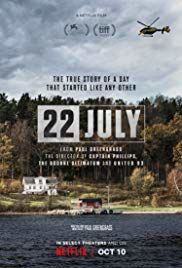Adolescence
Menace to Society
A review of 22 July: When the Unimaginable Happened in Norway
Posted October 20, 2018
Menace To Society: A review of 22 July: When the unimaginable happened in Norway

By Lloyd I. Sederer, MD
On 22 July, 2011, almost a decade after 9/11, a Norwegian Alt-Right citizen set off a massive car bomb outside a central government building in Oslo. He then proceeded, heavily armed, to an island, Utoya, some distance from Oslo, where an annual youth gathering was underway. In all, he murdered 77 people, principally teenagers, wounded over 200 others, and destined countless others to live with the agonizing, traumatic aftermath.
This extraordinary film, faithful to the people and events, is not a documentary, but it might as well be. As a viewer, I felt I was there for the events leading to and to the actual terrorist acts: To bear witness to the profound impact on individuals, families, and the peaceable nation of Norway.
Norway had never experienced an attack of this magnitude. It was perpetrated by one man, Anders Breivik, in his 20s, with a back story of being a loner, suffused with xenophobic, neo-Nazi ideas. Before he leaves his mother’s home to commit horror, he puts up, on-line, his “Manifesto”. He believes he is saving his country, in fact, all of Europe. He is without compunction; a calculating killer out for blazing fame.
Central to the story line is one family: the mother, the elected mayor of a far northern town with a population of 2,000, her husband, and their two teenage sons, both of whom were targets in the slaughter. The younger son, Torje, was not shot but is inexorably traumatized by the deadly attack, and suffers with survivor’s guilt. The older son, Viljar, portrayed as an amiable, handsome young leader, sustains five gunshot wounds. He is saved by heroic police and medical care, but is left with fragments of a bullet, inoperable, in his brain. The winter landscape of sub-Artic Norway underscores the narrative’s message of icy pain.
In the wake of an unimaginable event such as this, we wonder, “why”? Why would, why could, anyone perpetrate a mass killing? At first, when Breivik goes to trial, he wants to plead not guilty by reason of insanity, not because he believes he is mentally ill, but to escape a lifetime in prison, and instead be remanded to a forensic psychiatric hospital. But an aggrieved community and nation cannot bear this plea, even after a court-ordered psychiatrist states he has schizophrenia. And Breivik, his arrogance and unfettered narcissism at work, his body coiled for action, himself retracts his insanity plea. He wants his day in court - to lecture all present in the courtroom, the nation, and the world that he is their savior, and that they will, in time, honor him for what he has done. Very creepy.
The essential medico-legal issue in insanity pleas regarding whether a person is culpable and legally responsible for a horrific act is not whether that person has a mental illness. But rather, did he understand what he was doing at the time of the crime? The evidence we see in this film is overwhelming: he bought near to a ton of fertilizer and nitroglycerin and fashioned a home-made car bomb. He bought high-powered weapons, a cache of bullets, and a police uniform to enter the island youth sanctuary openly. And he systematically butchered one youth after another, until he surrendered to police who had arrived by boat, to save his own skin.
The resilience of the two teenagers featured, as well as a third youth, Lara (a dark haired, dark eyed child of migrants among the fair Scandinavians), and the families we meet is both inspiring and tragic. No one should have to suffer like this. Yet, evil, as embodied in Breivik, exists - and can erupt unpredictably and catastrophically. Our country today is on high alert for terrorism, organized by groups or the work of one person (man). We have surely prevented many a tragedy. While we are not powerless, we cannot prevent or beat back every terrorist act. Breivik states he has “no regrets”, would “…do it all again.” Such is the nature of a remorseless killer, where festering hate and ambition drive him.
22 JULY, which appears in theaters and is being streamed by Netflix, was written and directed by Paul Greengrass (who gave us United 93 in 2006, and three Jason Bourne films). He spent great time and attention with the survivors to do justice (sic) to their story, and to determine how best to depict the killings so that we see the terror and murders, yet without gratuitous violence. Every scene we see met the approval of the surviving families.
As the film concludes, Breivik enters a prison cell to spend the rest of his life in solitary confinement; the youthful Norwegian Prime Minister has been able to hold his country together (and later became the Secretary General of NATO); and the young people and families, the survivors, labor to find purpose - and to not let evil rule the day.
…………………..
Dr. Lloyd Sederer is a psychiatrist, public health doctor and medical journalist.
His new book is The Addiction Solution: Treating Our Dependence on Opioids and Other Drugs (Scribner 2018).


